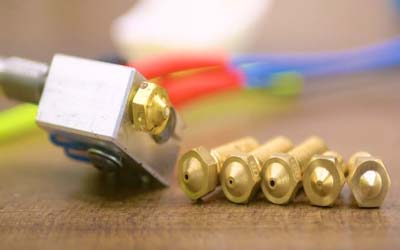
3D printing has opened up a plethora of new possibilities in multiple industries in the last decade. Be it automotive, education, jewelry or healthcare – this technology has brought in so many revolutionary changes in these sectors. None of these would be possible without incorporating the right nozzle in their process.
Without the correct nozzle type or size, your product will fail to highlight the required features as your client desired.
That is why every 3D printing enthusiast needs to know the 3D printer nozzle size and types variations. Here we discuss them in details so that you can make an informed decision in the end.
3D Printer Nozzle Sizes
1. Small
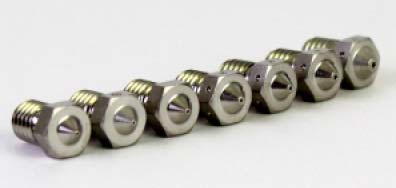
Measurements:
The smallest nozzles for 3D printing have an input diameter of around 0.1 to 0.25 mm. Among them, the specific sizes you will usually find available are 0.1, 0.15, 0.2 and 0.25 mm.
It would be wise to invest in the one whose size matches with the smallest detail on your usually 3D projects. Otherwise, there may not be a good use for that nozzle anymore and it may prove to be a waste of money.
Features:
Finest Details
If your 3D printing project requires the highest level of precision, you can settle for any of these nozzle sizes. They will make it possible for you to add the finest details on your creation to make the product stand out from the rest.
Using such sizes, you will be able to replicate the realistic miniature version of different items, people or characters. This can help you to produce impressive action figures of popular personalities in comics, movies and TV shows.
Besides, you can develop minuscule editions of many well-known automobiles, highlighting their extravagant features in a humble manner. Even their steering wheels, speedometers and seat belts can be recreated while maintaining their real-life attributes in this version.
Easily Removable Supports
Support structures are one of the many characteristics that make 3D printing a unique process. With the support of these structures, your product manages to defy gravity for a while and successfully reaches the final stage of creation.
If you use smaller nozzles, removing such structures after completing the process becomes easier. The amount of filament used here is less than usual because of the heightened precision. As a result, you may find it easier to just break them away once they have done their job.
See our related article on How to Remove Supports for 3D Printing. Avoid warping and breakage using our tips and tricks!
Prone to Clogging
One of the downfalls of using such tiny nozzles is that they are more prone to clogging than others. Since their input area is really compact, even a small particle can make the hot end clogged and halt the entire process.
In order to avoid such situations, you need to invest in high-quality filaments which can pass through the small nozzles effortlessly.
Difficulties With Overhangs
It can be hard to print out overhangs while working with a small nozzle. Since the width of each layer in the overhang is quite short, the next one struggles to keep up with its help. That is why these parts suffer quite a bit, and it becomes quite difficult for you to both create them and remove them.
2. Medium
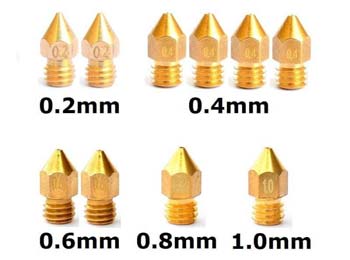
Measurements:
The medium range of 3D printing nozzle sizes is the most common type used in this industry. In terms of measurements, their inner diameter tends to be somewhere between 0.3 and 0.4 mm.
Specifically, the sizes available in this range are 0.3, 0.35 and 0.4 mm. The last one is in fact considered to be the standard size for 3D printing projects.
Features:
Good Speed And Precision
The biggest reason for the popularity of this range of nozzle sizes in 3D printing is the balance it provides between precision and speed. You don’t have to lose much on either side while working with them. It can provide your project with the necessary details and not take up too much time while doing so.
As a result, you can deliver your customers the details they wanted rather quickly. Since the speed is quite decent, you can also take more orders and deliver them all on time.
Read our related article on How to Speed Up 3D Printing. Get the most out of your project and your printer with these tips to speed up the process!
Works For Most Projects
For most 3D printing projects, the standard nozzle of 0.4mm works just fine. So you can get a lot done by investing in only one size.
If you have been looking for something universal for such nozzle sizes, this is the closest you can find. While there is no one-size-fits-all option, you may start 3D printing with this one.
0.1-0.3mm Layer Heights
Using these nozzle sizes, you can build 3D items that require a layer height within the range of 0.1 mm and 0.3 mm. This gives you plenty of room to explore your creativity and competence. In order to get better details, go for the thinner layers. On the other hand, thicker layers can get the job done much faster.
3. Large
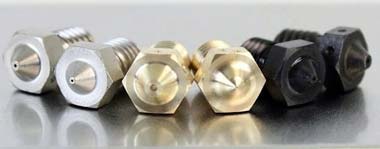
Measurements:
Among all the nozzle sizes, the larger ones probably come with most versatile measurements. The large nozzles for 3D printing are usually ranged between 0.5 to 1.2 mm. You can find them in the exact sizes of 0.5, 0.6, 0.8, 1.0 and 1.2 mm. Choose the one that suits your usual project requirements the best!
Features:
High Strength
Since these nozzles can extrude a thicker string of filament, the resulting object also becomes stronger than usual. So if you are currently involved in the task of producing something that needs to be heavy, sturdy and highly durable, the larger nozzles may come in handy.
High Speed
One of the best aspects of working with these nozzles is how fast it gets the job done. The speed of 3D printing improves noticeably when the nozzles discharge more filament in less time. Thus if the quantity of produced items or productivity matters a lot in your business, you can switch to the larger nozzles.
3D Printer Nozzle Types Based On Material
1. Brass
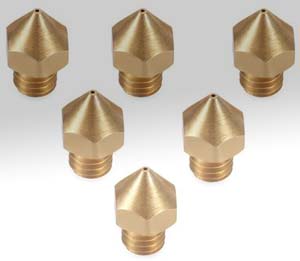
The most common material used by manufacturers for building nozzles is brass. This metal will allow you to explore a wide range of filaments except for the abrasive ones. It is compatible with popular filament choices like PETG, PLA, ABS, TPE and Nylon.
Almost every printer supporting FDM comes with a brass nozzle. The main reasons behind such widespread use are its affordability and simplicity. Besides, the resulting product will have great stability and thermal conductivity.
2. Stainless Steel
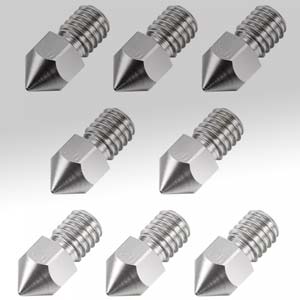
Stainless steel is known to be one of the most durable materials in many industries. However, in the case of 3D printing, it can be less reliable than other alternatives.
While it works fine with abrasive filaments for occasional use, doing so for an extended period will shorten its lifespan. As a result, you may find yourself replacing the stainless steel nozzle more frequently than other more durable options.
By investing in a stainless steel nozzle, you can make 3D printed products using filaments like NylonX, carbon fiber, glow-in-the-dark and more. Among the metal ones, it is compatible with filaments filled with steel, iron and brass. For the exotic filaments, you can go for the ones filled with wood or ceramic.
3. Hardened Steel
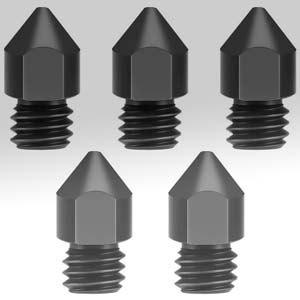
Another widely used material for 3D printing nozzles is hardened steel. The most appealing aspect of this material is its impressive durability and compatibility. Unlike the two options we have discussed above, this type can work with both abrasive and non-abrasive filaments on a regular basis.
If your projects usually deal with abrasive filaments, you can go for hardened steel. It will not wear or tear even after working with such materials frequently. In fact, it is known to be 10 times more resilient against this kind of erosion. As a result, they last a long time.
A possible challenge you may face while working with it is the high printing temperature demanded by the nozzle. Other than that, you can use it for almost any filament including carbon fiber, glass fiber and the ones filled with steel, iron or brass.
4. Specialty
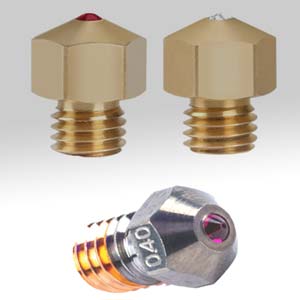
For those of you who like to take things one step further or prefer exotic options in 3D printing, there are some special nozzle materials. Upon searching, you can easily find rare nozzles made out of ruby, tungsten and similar unique materials.
The ruby and tungsten nozzles bring in exceptional durability, superior precision, great stability and good thermal conductivity. They can work with lots of abrasive filaments on a regular basis. The only drawback with these nozzles is their expensive price point.
Types Of 3D Printer Nozzle Based On Shape
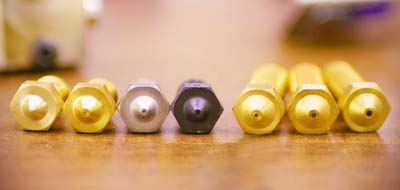
1. Flat-head
Some nozzles have a flat head that the filaments go through. You can go for such a shape if your projects require more sturdiness than speed. There doesn’t need to be much struggle to set the nozzle in place and get the process going.
However, once the filament has been ejected, it will take longer to cool down in flat head nozzles.
2. Pointed
If you value your time more than anything, the pointed nozzles will be a great choice for your 3D printing projects. They don’t demand much time for heat transfer after depositing the filament in place and cools down rapidly.
A potential drawback is that you will need to put in extra effort into accurately positioning the nozzle. Making a mistake in this regard can result in scratches.
Conclusion
The world of 3D printing is wide and diverse. There are many options of nozzles for you to choose from here – be it based on size, material or shape. It all depends on your individual business or project requirements.
Abrasiveness, sturdiness, speed and thermal conductivity are the four major factors to keep in mind while finding out your ideal choice of 3D printer nozzle size and types. We are sure you will land on the most suitable one from the comprehensive guideline provided here.
Other Printer Related Article: